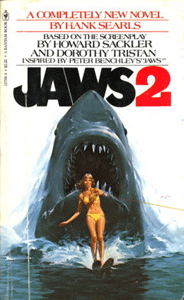As I noted in my review of Peter Benchley’s “Jaws” novel (1974), Steven Spielberg’s film streamlined the plot and eliminated all the subplots. In the early going of its production, the “Jaws 2” movie (1978) aimed to be a more proper representation of Benchley’s world-building, while also being a sequel.
Inspired by Benchley
Screenwriters Howard Sackler and Dorothy Tristan eventually simplified the film into a decently entertaining “American Graffiti with Sailboats, Plus Sharks.” So the Benchley “Jaws” universe again was relegated to the printed page, this time via Hank Searls’ novelization based on an early screenplay.
Hitting bookshelves two months before the film, Searls’ “Jaws 2” is a sequel to the plot of the “Jaws” movie. Instead of having three kids as in Benchley’s book, the Brodys have two. The elder, Mike (amalgamated from Benchley’s Billy and Martin Jr.), has a lingering fear of sharks since seeing a kid plucked from his yellow raft near him (as per the film). And Mayor Vaughan is still in office, rather than skipping town for a fresh start as per Benchley’s work.

“Jaws 2” (1978)
Author: Hank Searls
Series: “Jaws” No. 2
Genre: Thriller
Setting: Amity, N.Y., late 1970s
On Tuesdays this summer, Reviews from My Couch is highlighting classic (and not so classic) shark horror entertainment through the years.
Fans of the “Jaws 2” film will appreciate that the opening water-ski attack, the sailboat regatta and the concluding electric shark shock are in Searls’ book.
But Searls’ novelization is more aligned with Benchley’s novel than either film in terms of world-building. The Mafia plays a big part in town politics. At first blush, it’s laughable to integrate the Mafia and a killer shark, but it plays reasonably well.
You’re gonna need a bigger shark
Since sequels always go bigger, this new great white shark is a female (the larger of the genders among sharks) with five babies among her two uteruses. Benchley’s book builds on the fear of the unknown; Searls draws fear from what’s known.
The author – whose style is smoother than the hardboiled Benchley — describes how this large female is ravenous with hunger for the sake of her babies. A shark’s brain is like a computer (at one point spelled “computor,” as was sometimes the case in the word’s early days), and one of its programs is to not kill her babies. Hence, her hunger will decrease when they are born. I don’t know how accurate this science is, but it’s interesting.
Searls does good work showing the condition of a young diver who surfaces too quickly while dodging the shark, and is hospitalized with an air bubble in his brain. (Before the regatta, Mike is interested in deep-sea diving. I can see why the screenplay was tightened to narrow his water-based interests to sailing.)

A knowledge problem
Rather than a slow build-up about the very notion of a shark circling the waters off Amity Sound, “Jaws 2” flat-out delays people’s knowledge of the shark till the end. This should be frustrating to a reader, but I didn’t mind it, because Searls sells the knowledge gap well.
For one thing (not counting low-grade fear from Chief Martin Brody and son Mike), few people believe there could possibly be a second killer shark in Amity within a couple years. When evidence does trickle in, some believe Brody lied about the shark’s death in “Jaws.”
For another, people are distracted by economics, politics, everyday crime and organized crime. Brody finds a summer renter named Jepps shooting at barking seals. Jepps is a cop in another New York town who has Mafia links. The Mafia is key to the construction of a casino in Amity that will boost the economy.
Long story short: Brody obsessively theorizes that Jepps has killed all the people that we, as readers, know are shark victims.
Grand finale
This allows for a gripping finale wherein Brody and the dive instructor search for the Navy’s sensor ball (the reward could help pay for the student’s hospital bills), and a mob hit is playing out, and the regatta is launching, and a storm is approaching.
As the teens cluster around a buoy in the storm, the shark picks off outside sailboats, leaving them with fewer and fewer tiny wooden boats to cluster on to. Inexperienced seaman Brody tries to pick them up in his big boat as a storm and a pregnant shark rage around them. Meanwhile, young Sean Brody is out there in another sailboat.
The “Jaws 2” film did a decent job of showing the sailboats strung together as a shark looms, but Searls’ writing is more intense. It’s an example of how a good writer can paint a picture that a modestly budgeted film can’t recapture.
In the end, we have a repeated instance of a straightforward thriller film pairing with a more complex novel. And again, I recommend both of them. Searls’ work is not only a glimpse into how screenplays get streamlined as filming nears, but also of a plain ole good novel set in the wider “Jaws” universe. It’s an alternate story, rather than a mere change of medium.

